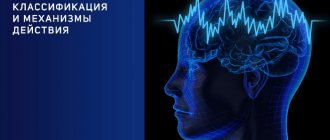Tranquilizers are classified as psychotropic drugs, since the main target of their action is the mental sphere and they are used to treat mental illnesses and painful conditions in healthy individuals. In addition to tranquilizers, psychotropic drugs include antipsychotics, antidepressants, mood stabilizers, nootropics and nervous system stimulants.
The first tranquilizer MEPROBOMAT
was synthesized in 1952. Thus, the history of the use of drugs in this group goes back more than 60 years.
Most drugs in this group, in addition to their sedative effect, have the ability to reduce muscle tension, make it easier to fall asleep, and stabilize autonomic reactions: palpitations, pressure surges, tremors, dizziness and headaches.
Tranquilizers
- a large group of drugs that are different in structure and mechanism of action, but what they have in common is a decrease in the excitability of the subcortical structures of the brain responsible for emotional reactions.
General restrictions for all drugs in this group are incompatibility with alcohol (they enhance each other’s effects), and prohibition on use by persons performing complex responsible actions that require increased concentration and instant reaction (drivers, pilots, machine operators, etc.) .
Depending on the chemical structure, tranquilizers are divided into several groups (according to M.D. Mashkovsky). List of tranquilizers by group:
BENZODIAZEPINES
One of the most common tranquilizers. They are widely used in the practice of psychiatrists, psychotherapists, psychiatrists - narcologists, neurologists, cardiologists, surgeons, anesthesiologists and resuscitators. With long-term use they can cause dependence (mental and physical). Benzodiazepine tranquilizers have a specific antagonist (a drug with the opposite effect) - FLUMAZENIL (anexate), which is used to stop breathing and loss of consciousness in cases of overdose and poisoning with benzodiazepines.
- Chlozepid (Librium, Radepur, Chlordiazepoxide, Elenium). The very first benzodiazepine tranquilizer with a strong sedative effect. Sibazon (Relanium, Relium, Seduxen, apaurin, diazepam).
- Bromodihydrochlorophenylbenzodiazepine (phenazepam, elzepam). Domestic development, widely distributed in the countries of the former USSR.
- Nozepam (tazepam, oxazepam).
- Lorazepam (calmese, loram, lorafen).
- Bromazepam (Lexilium).
- Mezapam (rudotel, medazepam).
- Gidazepam.
- Estazolam (nuctanol).
- Clorazepate (Tranxene).
- Clobazam (freesium).
- Alprazolam (Xanax, Zoldac, Neurol). One of the most powerful drugs in this group.
- Tetrazepam (myolostane).
- Tofisopam (Grandaxin). It is distinguished by its ability to have an activating effect.
Features of application
The most commonly used benzodiazepine drugs are diazepam and phenazepam. If they are canceled, the effect weakens gradually, this is due to the formation of long-acting, active metabolites. That is why these drugs must be discontinued immediately after completing a short course of treatment, without fear of withdrawal syndrome.
For elderly patients or those with impaired liver function, the best choice is short-acting benzodiazepines, for example, tazepam, lorazepam. These drugs are quickly transformed into glucuronides - inactive metabolites, the metabolism of which does not depend on the condition of the liver and age - because they are easily soluble in water and are quickly excreted by the kidneys.
It is also possible to use other short-acting benzodiazepines; one of these drugs is midazolam. One of the disadvantages of such drugs is the need to frequently repeat injections and gradually reduce the dose when discontinued.
Most often used:
- Relanium – 0.5% solution of diazepam – 2-4 ml intramuscularly, either intravenously or intravenously, the daily dose should not exceed 0.06g
- phenazepam tablets 0.0005, 0.001, daily dose within 0.01 g;
- phenazepam solution 0.1% from 1 to 4 ml intramuscularly, intravenously or intravenously; lorazepam 0.0025 to 0.015 g/day; tazepam 0.01 to 0.09 g/day.
Possible side effects:
- daytime sleepiness, lethargy, exercise intolerance;
- decreased reaction severity and speed of thinking, therefore taking drugs from the benzodiazepine group imposes certain restrictions on activities associated with the need for constant concentration (driving a car, machinery, etc.);
- impaired coordination (if the therapeutic daily dose is observed, they occur quite rarely);
- decreased libido, potency;
- hypotension, arrhythmia.
But in general, adverse reactions are rare, which makes it possible to use benzodiazepines not only in inpatient, but also in outpatient addiction treatment.
The text was checked by expert doctors: Head of the socio-psychological service of the Alkoklinik MC, psychologist Yu.P. Baranova, L.A. Serova, a psychiatrist-narcologist.
CAN'T FIND THE ANSWER?
Consult a specialist
Or call: +7 (495) 798-30-80
Call! We work around the clock!
Use of tranquilizers
The main indications for taking these drugs are mild mental disorders and behavioral disorders:
- Neuroses. Neurosis-like conditions.
- Personality disorders.
- Anxiety disorders: panic attacks, phobias, generalized anxiety disorder, mixed anxiety and depressive disorder.
- Withdrawal state (withdrawal syndrome) with alcohol, nicotine, drug addiction, substance abuse and polydrug addiction.
- Depression with anxiety.
- Schizotypal disorder.
- Acute psychoses (in combination with other drugs).
- Consequences of organic damage to the central nervous system with mental disorders
- Behavioral disorders in children and adolescents.
- Insomnia.
- Eating disorders (anorexia, bulimia).
- Psychosomatic diseases: eczema, irritable bowel syndrome, “neurogenic bladder”, asthma attacks, hypertension and arrhythmia.
In addition, they are widely used in neurological practice: consequences of traumatic brain injuries, strokes with increased muscle tone, epilepsy, spinal osteochondrosis, etc. In therapeutic practice: functional disorders in the gastrointestinal tract, cardiovascular, urinary and other body systems.
Is it possible to take tranquilizers on your own without a doctor?
No. These are psychotropic drugs that have their own contraindications and limitations. Self-administration is life-threatening.
Can you buy tranquilizers without a prescription?
No. They are prescribed only on prescription by a doctor who has grounds for prescribing this drug. Two tranquilizers are prescribed on special strict reporting prescription forms (form 148 - 1/u - 88), these are sibazon and alprazolam.
What are the most powerful tranquilizers?
Sibazon and alprazolam.
What are daytime tranquilizers?
Since most tranquilizers tend to cause daytime sleepiness, drugs have been synthesized without this side effect. These include: gidazepam, clorazepate, tofisopam, hydroxyzine, mebicar.
What is the difference between tranquilizers and antidepressants? Do they have anything in common?
The difference between them is in the mechanisms of action (they act on different types of receptors). They have different therapeutic effects (anti-anxiety and antidepressant, respectively). Tranquilizers are often prescribed once or in short courses, antidepressants are prescribed for a long time, several months.
What they have in common is that they are all psychotropic drugs. Some drugs from these groups can give a hypnotic, sedative and anti-aggressive effect.
Use by drug addicts
People with drug addiction resort to the use of pharmaceuticals with psychotropic effects to obtain euphoria and drug intoxication. Despite the fact that benzodiazepines are used in narcology to treat addiction to ethanol, amphetamines, opiates and hallucinogens, drug addicts do not use them for therapy, but, on the contrary, to get a high. The mechanism of action of benzodiazepines on the nervous system is similar to narcotic substances and ethyl alcohol. Most often, for their purposes, they choose Phenazepam, Diazepam, Lorazepam, Nozepam, etc.
Symptoms of benzodiazepine addiction are determined by the chemical effects of the drugs. Immediately after taking them, a person looks lethargic and lethargic, he practically sleeps, since all processes in his brain slow down sharply. After the effects of the medications wear off, consciousness gradually returns, while the drug addict exhibits excessive irritability and aggression against the background of weakened reflexes, altered gait and speech.
With prolonged abuse of benzodiazepines, seizures, drug-induced parkinsonism, vomiting, weight loss and consciousness disorders are recorded as a result of destructive changes in brain tissue. At the same time, drug addicts are not limited to one type of psychotropic drugs. They choose medications from different pharmacological groups and constantly alternate them with each other. The dose of benzodiazepines required to achieve drug intoxication is much higher than the therapeutic dose.
The result of such abuse is the destruction of personality against the background of intellectual, moral and behavioral disorders. A person degrades by showing disrespect for loved ones, forgetting about basic ethics and norms of society. He loses his ability to work, unable to cope with mental and physical stress.
Traditional anxiolytics
Benzodiazepine derivatives have been used in medicine for 60 years - their first representatives, diazepam and chlordiazepoxide, began to be used in the 60s of the last century. It turned out that radicals in the benzodiazepine molecule are easily replaced, and thanks to this, more than 3,000 compounds were synthesized over several decades. More than 40 of them are used as anxiolytics (2).
Main properties of benzodiazepines:
- anxiolytic (tranquilizing);
- sedative;
- hypnotic;
- anticonvulsant;
- muscle relaxant;
- amnesiac.
In addition, drugs of this subgroup exhibit antiphobic, activating, antidepressant, antihypoxic, hypotensive, antiarrhythmic, analgesic and some other effects [3].
The action of benzodiazepines is aimed at the most important parts of the limbic system, in which neurons are activated by external impulses: the hypothalamus and cerebral cortex. The activity of the drugs is primarily associated with the ability to facilitate the postsynaptic action of gamma-aminobutyric acid (GABA) due to binding to receptors located on the synaptic membrane of GABAergic neurons [2, 3]. Let us remind you: GABA is the main inhibitory transmitter of the central nervous system, which is released in approximately 1/3 of all synapses.
Despite low toxicity and good tolerability, long-term use of benzodiazepines, especially in high doses, can lead to withdrawal syndrome, as well as psychological and physical dependence. Therefore, benzodiazepines are discontinued gradually. [2, 3].
An atypical drug occupies a special place in the group of benzodiazepine anxiolytics
tofisopam. It differs from traditional benzodiazepines in the location of the nitro group, which determines its unique properties. Tofizopam does not have a muscle relaxant or anticonvulsant effect, does not affect cognitive functions and can be prescribed in situations requiring concentration and important decision-making. In addition, unlike other benzodiazepines, the use of tofisopam is much less likely to develop mental or physical dependence, as well as withdrawal symptoms. At the same time, tofisopam exhibits anxiolytic effects characteristic of benzodipazepines [4].
Among drugs of other chemical structure
It is worth mentioning tetramethyltetraazabicycloocanedione. Its molecule consists of two urea fragments in a bicyclic structure, due to which the drug is structurally close to the body’s natural metabolites [5].
Like all benzodiazepines, tetramethyltetraazabicycloocandione acts on structures included in the limbic-reticular complex. It also affects all 4 major neurotransmitter systems - GABA, choline, serotonin and adrenergic. Due to this, the drug has an anti-anxiety, calming effect, without reducing mental and motor activity. Therefore, it can be used during the working day. The drugs do not exhibit a hypnotic effect, but enhance the effect of sleeping pills. It should be noted the ability of this drug to improve cognitive functions, attention and mental performance. In addition, unlike benzodiazepines, it does not cause dependence or withdrawal symptoms [5].
When dispensing tetramethyltetraazabicyclootcanedione, it should be noted that the drug can cause a decrease in blood pressure, weakness, and also negatively affect the ability to drive a car, so drivers should be especially careful [5].
Mechanism of action of benzodiazepines
All drugs are poisons. They interfere with the functioning of the central nervous system. Benzodiazepines, tranquilizers, sleeping pills - all of them are also poisons.
Their effect differs depending on the dose size:
- a small dose stimulates (the body speeds up metabolism to remove the poison faster);
- the average dose calms (the body slows down metabolic processes);
- a large dose causes death.
Benzodiazepines in a certain dose reduce the excitability of neurons (nerve cells that transmit signals). Under the influence of poison, a person more or less loses touch with reality. Including, he “loses connection with the body” - he ceases to feel pain and malaise.
Poisons are fat-soluble substances. Together with the blood, they are carried to all corners of the body, some of them are stored in adipose tissue. Because of this effect of benzodiazepines, even months or years later, a person may feel lethargic, tired, irritable, and other negative things. This occurs when particles of toxic deposits enter the bloodstream. To counteract poisons, the body uses vitamins and minerals, which creates a deficiency in the body. A smoker, for example, needs to take an additional 2000 mg of vitamin C every day.
Poisons gradually worsen a person’s normal mood over and over again. They impair memory, reduce the ability to learn, analyze and quickly make correct decisions. They have a detrimental effect on moral values. These mechanisms lead to regular slow degradation, physical and mental. Both those and other things are included in the list of side effects.
What drugs are benzodiazepines?
In addition to Phenazepam, the list of such drugs includes:
- Gidazepam;
- Diazepam;
- Clobazam;
- Clonazepam;
- Xanax;
- Librius;
- Lorazepam;
- Midazolam;
- Nordiazepam;
- Serax;
- Chlorozapat.
Over time, the use of antidepressants, sleeping pills and anti-anxiety medications has increased. About 30-50 years ago, the word “depression” was new to us; we only went to the pharmacy for brilliant green or aspirin. And now it has become “fashionable” to solve psychological problems with the help of pharmaceutical products. However, this is not just “wrong”, it is truly dangerous, given the full range of side effects, including decreased attention and concentration and the risk of injury and accidents, aggressiveness, violence and suicidal tendencies, memory impairment, learning disabilities and other effects.
Poisoning and overdose
Exceeding the dose of benzodiazepines leads to too much depression of the central nervous system. Symptoms of poisoning:
- fatigue;
- exhaustion;
- dizziness;
- unclear speech;
- confusion;
- paradoxical actions such as agitation and nervousness;
- decrease in body temperature and blood pressure;
- headache;
- nausea, vomiting, diarrhea;
- respiratory arrest, coma and other complications (with a very large overdose).
With an overdose of tranquilizers, blood pressure decreases, cardiac activity is disrupted, breathing becomes rare, and the patient may fall into a coma.
If you notice symptoms of poisoning, it is important to quickly take the right actions:
- call an ambulance;
- induce vomiting, perform gastric lavage (if the patient is conscious and if no more than 1 hour has passed since taking the dose).
Doctors will take further action. Taking these medications with alcohol and other drugs can lead to an overdose. Alcohol or other drugs are added to the toxic effect of one drug; they reinforce each other.
Those who abuse benzodiazepines experience withdrawal symptoms (in other words, drug withdrawal): irritability, insomnia, nausea, convulsions and other unpleasant symptoms.








